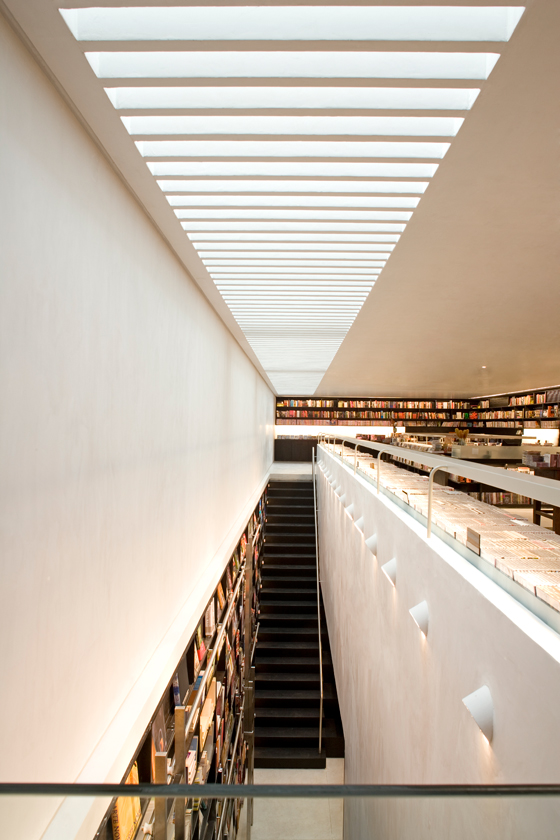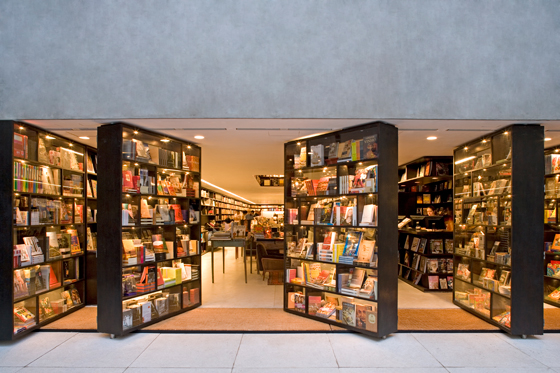Shelf-life
Scritto da Dominic Lutyens
London, Regno Unito
16.12.14
In the retail world, bookstore interiors are arguably changing more radically than in any other sector. Time was when bookshops appealed for being old-world and fusty, with their labyrinthine layouts, faintly musty smells and eccentrically bookish proprietors. One example might be Paris’s Shakespeare and Company bookshop, founded by Sylvia Beach in 1919. Fast-forward to the 1990s, and bookshops had become megastores incorporating cafés and comfortable leather armchairs where customers could browse for hours and sip cappuccinos.
With its apertures connecting different floors, Isay Weinfeld’s Livraria da Vila bookstore in São Paulo anticipated the trend for more transparent interiors in bookshops that’s now increasingly common

With its apertures connecting different floors, Isay Weinfeld’s Livraria da Vila bookstore in São Paulo anticipated the trend for more transparent interiors in bookshops that’s now increasingly common
×Since then, scores of bookshops have closed because of competition from online retailers, cut-price supermarkets and e-books. Yet booksellers are fighting back, commissioning cutting-edge architects to design shops with a boldly contemporary aesthetic. Last year, Foyle’s in London opened a new flagship store designed by Lifschutz Davidson Sandilands, which — luminous, spacious and easily navigable — is the antithesis of the trad bookstore.
Another view of the store, formerly a two-storey house on a narrow site. The top floors have no windows, but skylights draw natural light into the store

Another view of the store, formerly a two-storey house on a narrow site. The top floors have no windows, but skylights draw natural light into the store
×A similar approach is sweeping Brazil, clearly a nation of bibliophiles, judging by its many vast, not to say ultra-modern bookshops that have been springing up for some years. A seminal example is São Paulo’s Livraria da Vila bookstore, designed in 2007 by Brazilian architect Isay Weinfeld, which bridges the style of traditional bookshops and contemporary ones. While the current vogue in bookshops is for almost gallery-like, white walls combined with honey-toned wood and pops of bright colour, Livraria de Vila plays with stark tonal contrasts: its shelves are in white or a cigar-brown wood redolent of gentlemen’s clubs. That said, being open-plan, the shop anticipates the future trend for transparent interiors.
A note of whimsy is struck by revolving bookcases — suggestive of opening a book — that line the store front

A note of whimsy is struck by revolving bookcases — suggestive of opening a book — that line the store front
×More modern and clean-lined is São Paulo’s 2,500-square-metre Livraria Cultura, completed in 2013. Designed by Marcio Kogan, Diana Radomysler, Luciana Antunes, Marcio Tanaka and Mariana Ruzante of Studio MK27, and incorporating an exhibition space, conference area and garden café, it’s as much a see-and-be-seen hang-out as a bookshop. It also recalls an upscale department store or elegant airport lounge with its escalators ascending to a top-floor, open-plan, double-height space with 21-metre-wide, tiered, wooden benches where customers can spend time with friends or read. White bookshelves incorporating LEDs, white laminate surfaces and glass handrails on the staircases all contribute to the shop’s luminous, transparent feel.
The top floor in MK27’s Livraria Cultura, in São Paulo’s Iguatemi shopping centre. Its lead architect Marcio Kogan describes the shop, which also hosts cultural events, such as a ‘Bookstore of the 21st Century’

The top floor in MK27’s Livraria Cultura, in São Paulo’s Iguatemi shopping centre. Its lead architect Marcio Kogan describes the shop, which also hosts cultural events, such as a ‘Bookstore of the 21st Century’
×A mezzanine level skirts the periphery of Livraria Cultura’s top floor, providing access to books on the uppermost shelves

A mezzanine level skirts the periphery of Livraria Cultura’s top floor, providing access to books on the uppermost shelves
×At one end of wide wooden benches that resemble seating in a stadium, white stair treads have been cleverly added to create a staircase

At one end of wide wooden benches that resemble seating in a stadium, white stair treads have been cleverly added to create a staircase
×There are similarities between Livraria Cultura and architect Arthur Casas’s 2013 design for the Rio de Janeiro flagship store of Brazilian bookseller Saraiva. After all, it has a double-height, open-plan ground floor, furniture to lounge on and a gleaming escalator. With its white walls and wooden shelves, its decor is neutral but for one touch — the books on the top shelves are arranged by colour rather than category, creating an unexpectedly pop, rainbow-hued effect.
At leading Brazilian bookseller Saraiva’s flagship store in Rio de Janeiro, designed by architect Arthur Casas, books on the higher shelves are arranged by colour not category, to decorative effect

At leading Brazilian bookseller Saraiva’s flagship store in Rio de Janeiro, designed by architect Arthur Casas, books on the higher shelves are arranged by colour not category, to decorative effect
×The area below, dotted with furniture by Sergio Rodrigues, was designed to feel like a public square

The area below, dotted with furniture by Sergio Rodrigues, was designed to feel like a public square
×The basement is devoted to a children’s area. A ramp with multicoloured stripes inevitably echoes the store’s conceit of arranging some books by colour rather than by category

The basement is devoted to a children’s area. A ramp with multicoloured stripes inevitably echoes the store’s conceit of arranging some books by colour rather than by category
×In short, across the globe, bookshops are turning over a new leaf as they battle to survive in the internet age. Today, they need to offer an environment that is refreshingly contemporary, welcoming and practical, where books and other items can be easily found.








